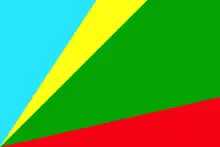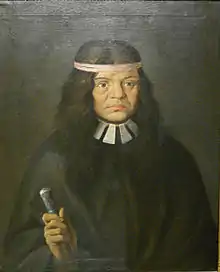Huilliche people
The Huilliche (Spanish pronunciation: [wi.ˈʝi.tʃe]), Huiliche or Huilliche-Mapuche are the southern partiality of the Mapuche macroethnic group in Chile and Argentina.[2] Located in the Zona Sur, they inhabit both Futahuillimapu ("great land of the south")[2] and, as the Cunco or Veliche[3][4] subgroup, the northern half of Chiloé Island.[5] The Huilliche are the principal indigenous people of those regions.[6] According to Ricardo E. Latcham the term Huilliche started to be used in Spanish after the second founding of Valdivia in 1645, adopting the usage of the Mapuches of Araucanía for the southern Mapuche tribes.[2] Huilliche means 'southerners' (Mapudungun willi 'south' and che 'people'.) A genetic study showed significant affinities between Huilliches and indigenous peoples east of the Andes, which suggests but does not prove a partial origin in present-day Argentina.[7]
 Flag adopted by the Aukin Wallmapu Ngulam in 1990. | |
 Catiguala, a cacique of the Huilliche in the 18th century | |
| Total population | |
|---|---|
| 17,000 in Chiloé Archipelago[1] | |
| Regions with significant populations | |
| Futahuillimapu and Chiloé Archipelago, Chile | |
| Languages | |
| Spanish (Chilean Spanish), Huilliche | |
| Religion | |
| Christianity (mainly Roman Catholic) | |
| Related ethnic groups | |
| Cunco people, Mapuche people, Picunche people, Chilean people, Veliche people, Payos |
During the 16th, 17th, and 18th centuries, the mainland Huilliche were generally successful at resisting Spanish encroachment. However, after the Figueroa incursion of 1792 Huilliches were decisively defeated and their territory was gradually opened to European settlement beginning with the Parliament of Las Canoas. Today, most Huilliche speak Spanish, but some, especially older adults, speak the Huilliche language.[1] Laurelia sempervirens, known in Huilliche triwe and in Spanish as laurel, is the ritual tree of the Huilliche of Futahuillimapu.[8]
The main modern areas of Huilliche settlement are two; San Juan de la Costa west of Osorno and Compu-Chadmo in the southeast of Chiloé Island.[9]
Colonization

16th century
In the 1540s Spanish conquereros led by Pedro de Valdivia arrived in Central Chile from newly conquered Peru. Between 1549 and 1553 the Spanish founded several cities in Mapuche territory and one in Huilliche territory: Valdivia.[10] Albeit the death of Pedro de Valdivia in 1553 halted the Spanish conquests for a while Osorno and Castro were established in Huilliche territory in 1558 and 1567 respectively.[10][11] The Spanish defeat by Mapuches in the battle of Curalaba in 1598 triggered a general uprising that led to the destruction of all Spanish cities in Huilliche territory except Castro.[2][12]
17th century
The portion of Futahuillimapu south of Maipué River became largely depopulated following a period of pillaging by the Spanish and loyalist Huilliches that had relocated from Osorno to the forts of Carelmapu and Calbuco.[2][13] After Valdivia was refounded in 1645, the Spanish struggled to establish a land route to the vicinities of Chiloé Archipelago across independent Huilliche territory.[2][14][upper-alpha 1]
There are reports in the 17th and 18th centuries of internal conflicts among the Huilliche. This may have stunted population growth.[2]
18th century
In late 18th century Basque navigator José de Moraleda wrote that Huilliches of Osorno were more stocky, agile and of general better appearance than the people of Chiloé.[2] Their ponchos were described by Moraled as less pleasing ("vistosos") than those of Chiloé.[2]
In 1792 the Huilliches were ravaged by a Spanish army led by Tomás de Figueroa.[16] A peace parliament and treaty was signed in 1793.[16] In the treaty Huilliche property was recognized by the Spanish.[16]
19th century
Sociedad Stuttgart, a society established in the 19th century to bring German settlers to Chile, purchased about 15 000 km2 under fraudulent conditions from Huilliches in the Precordillera east of Osorno.[17] This purchase was later ratified by Chilean courts and serves to illustrate how Chilean authorities ignored their own legal order that guaranteed Huilliche property.[17]
As result of the establishment of Chilean and European settlers, including Germans, around Bueno River, Osorno Huilliches living in the Central Valley migrated to the coastal region of Osorno.[17] In the 1920s, The economy of Osorno shifted towards cattle farming, with land ownership concentrated among the German immigrants, and many Huilliches became peasants of haciendas.[18]
See also
Notes
- The idea behind this road was to provide a provide pathway for reciprocal military aid in case of an invasion by a foreign power, likely Britain.[15]
References
- "Huilliche". Ethnologue. Retrieved 28 December 2013.
- Alcamán, Eugenio (1997). "Los mapuche-huilliche del Futahuillimapu septentrional: Expansión colonial, guerras internas y alianzas políticas (1750–1792)" (PDF). Revista de Historia Indígena (in Spanish) (2): 29–76.
- Urbina, Ximena; Reyes, Omar; Belmar, Carolina A. (2020). "Canoeros en Chiloé: de facilitadores de las navegaciones españolas en los archipiélagos los Chonos y de Guayaneco, a productores y comerciantes, 1567-1792" [Coastal hunter gatherers in Chiloé: From facilitators of the navigation of Spaniards in the Chonos and Guayaneco archipelagoes to producers and traders, 1567-1792]. Chungara (in Spanish). 52 (2). doi:10.4067/S0717-73562020005000702.
- Contreras Oyarzún, Constantino (2009). "Renato CÁRDENAS ÁLVAREZ y Jorge O. VÁSQUEZ V. Collags, poesía mapuche de Chiloé. Aproximaciones socioculturales a una compilación de poesía veliche hecha por Elias Necul de Caguach en 1887. Publicación de la Agrupación de Amigos Chachaén de la Biblioteca Pública de Achao: Imprenta Ojoentinta, 2008, 44 pp". Alpha (in Spanish). 29. doi:10.4067/S0718-22012009002900022.
- "Poblaciones costeras de Chile: marcadores genéticos en cuatro localidades". Revista Médica de Chile. 126 (7). 1998. doi:10.4067/S0034-98871998000700002.
- Villalobos et al. 1974, p. 49.
- Rothhammer, Francisco; Puddu, Giannina; Fuentes-Guajardo, Macarena (2017). "¿Puede el ADN mitocondrial proporcionar información sobre la etnogénesis de los pueblo originarios chilenos?" [Can mitochondrial DNA provide information on the ethnogenesis of Chilean native populations?]. Chungará (in Spanish). 49 (4). doi:10.4067/S0717-73562017005000028.
- Rumian Cisterna, Salvador (2020-09-17). Gallito Catrilef: Colonialismo y defensa de la tierra en San Juan de la Costa a mediados del siglo XX (M.Sc. thesis) (in Spanish). University of Los Lagos.
- Ramírez Sanchez, Carlos (1988). Toponimia indígena de las provincias de Osorno, Llanquihue y Chiloé (in Spanish). Valdivia: Marisa Cuneo Ediciones. pp. 17–18.
- Villalobos et al. 1974, p. 99.
- Hanisch, Walter (1982). La Isla de Chiloe, Capitana de Rutas Australes (in Spanish). Academia Superior de Ciencias Pedagógicas de Santiago. pp. 11–12.
- Villalobos et al. 1974, p. 109.
- Mansilla Almonacid, José D. (2002), "La Población de Calbuco Evolución de las Cifras. Siglos XVII-XX", Revista Austral de Ciencias Sociales (in Spanish), 6 (6): 125–134, doi:10.4206/rev.austral.cienc.soc.2002.n6-10
- Montt 1971, pp. 25–28.
- Couyoumdjian, Juan Ricardo (2009). "Reseña de "La frontera de arriba en Chile colonial. Interacción hispano-indígena en el territorio entre Valdivia y Chiloé e imaginario de sus bordes geográficos, 1600–1800" de MARÍA XIMENA URBINA CARRASCO" (PDF). Historia. I (42): 281–283. Retrieved 30 January 2016.
- Foerster, Rolf G. (1998). "Tratado de Paz de 1793. Una aproximación a la gramática de la memoria mapuche-huilliche" (PDF). Revista Austral de Ciencias Sociales (in Spanish) (2): 59–68. doi:10.4206/rev.austral.cienc.soc.1998.n2-06. Retrieved 25 December 2013.
- Concha Mathiesen, Martín (1998). Una mirada a la identidad de los grupos huilliche de San Juan de la Costa (Thesis) (in Spanish). Universidad Arcis.
- Vergara, Jorge Iván; Gundermann, Hans (2012). "Constitution and internal dynamics of the regional identitary in Tarapacá and Los Lagos, Chile". Chungara (in Spanish). University of Tarapacá. 44 (1): 115–134. doi:10.4067/s0717-73562012000100009.
Bibliography
- Alberto Trivero (1999); Trentrenfilú, Proyecto de Documentación Ñuke Mapu. (in Spanish)
- Montt Pinto, Isabel (1971). Breve Historia de Valdivia (in Spanish). Editorial Francisco de Aguirre.
- Otero, Luis (2006). La huella del fuego: Historia de los bosques nativos. Poblamiento y cambios en el paisaje del sur de Chile. Pehuén Editores. ISBN 956-16-0409-4.
- Villalobos R., Sergio; Silva G., Osvaldo; Silva V., Fernando; Estelle M., Patricio (1974). Historia de Chile (in Spanish) (1995 ed.). Editorial Universitaria. ISBN 956-11-1163-2.
